Overhauling a brand or even revamping a website may seem like an overwhelming endeavor, with months of work ahead, many stakeholders to please, and most likely several iterations to go through before you release the new brand. While rebranding can present many challenges, it can also produce large payoffs, from increasing sales to standing out from the competition.
To make sure your rebranding efforts are successful, here is what you should think about ahead of time.
What is The Main Reason for the Rebrand?
Is your website outdated? Do you need to align your brand identity with your target market to drive leads? Rebranding needs to be done for the right reasons.





Good Reasons to Think About
- Re-identifying your brand to address a change in company direction
- Staying relevant to your audience in a changing market
- Differentiating from the competition
- Driving awareness for a new product or service launch
What are Your Business Priorities?
Overhauling a brand can be costly and time consuming, so you’ll want to address how it will align with business objectives. Here are some important questions to ask:
What is the opportunity? Research how the market already perceives your current brand, and discover how changing your brand and related materials would improve brand awareness and drive sales.
Who is the target audience? Are they on board? Rebranding is never something to take lightly as it could cause negative reactions from your customers and most dedicated fans. Take the time to hear their feedback as well before you start making changes.
Do you have executive buy-in? Executives are more likely to support a rebrand if your company faces challenges, such as decreasing sales and increasing competition. From your research findings, demonstrate how a rebrand will help your business derive value in the long run.
How much will it cost? Keep in mind that the implementation process costs much more than redesigning a brand identity — 20 times more according to some estimates. From updating collateral at all touchpoints to making sure all of your stakeholders have the latest materials, rebranding can get expensive. Tungsten provides a price range for budgeting for branding costs, from company name development (5-15K) to corporate logo (2.5-5K) and so forth. Of course, these estimates can grow even more depending on the amount of service required, the number of assets and stakeholders involved.
Rebrand or refresh? Whenever you’re changing your brand, you’ll want to think about what equity you can reserve. Usually it’s better to refresh some collateral and evolve your brand, rather than update everything all at once.
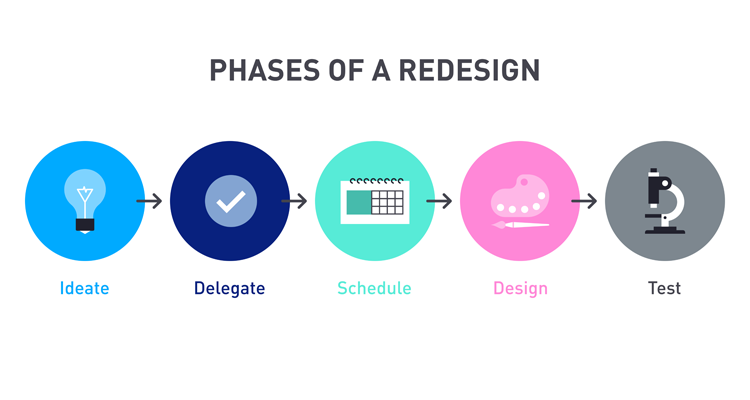
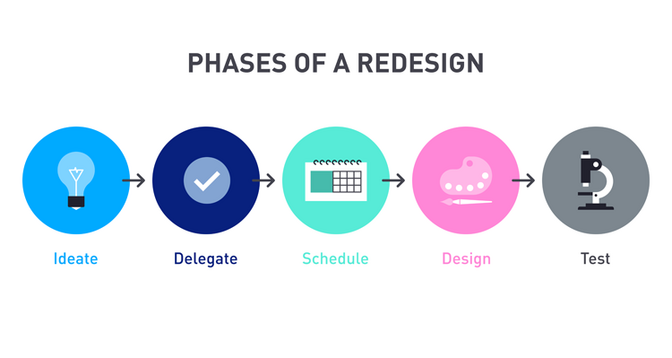
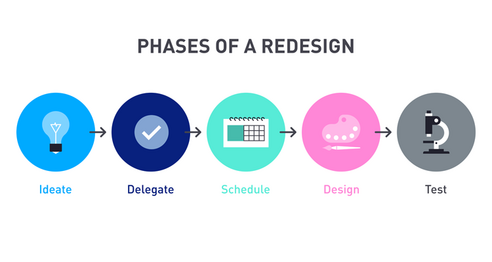
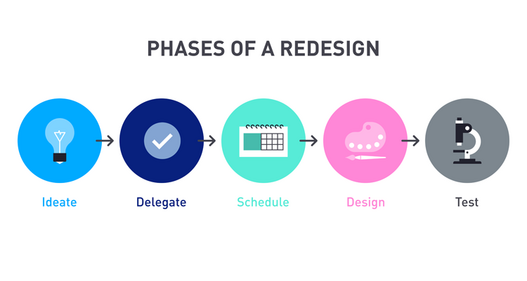
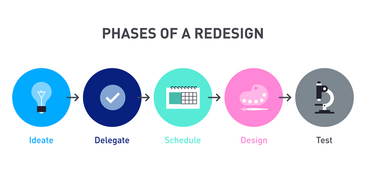
How to Redesign Your Brand
Once you’ve defined the opportunities in the market and collected information about how a rebrand will meet your business objectives, this is when the detailed planning begins. Depending on the size and scope of the rebranding project, you’ll want to map out various phases. Here’s a popular approach you could take:
Ideate – This is the time to “think big” in terms of concepts and outcomes. According to a “Design Thinking Process Guide” from the Institute of Design at Stanford, “Ideation is about pushing for a widest possible range of ideas,” from which you can select from. “The determination of the best solution will be discovered later, through user testing and feedback.” During the ideation phase, sketch, make diagrams, leverage a group for ideas—all the while thinking about how the rebrand will look through the eyes of your customers. Once you’ve come up with several ideas, get your stakeholders to take a vote on the best ones.
Delegate – Before you start to design, you’ll want to do a little extra planning to figure out who will be involved in the design process. Do you need to hire a designer? How about a creative agency? Will developers be involved? You’ll also need to know who are the senior managers that will provide approval of your designs. (Make sure they’ve agreed to the ideas and concepts that were documented during the ideation phase). Write a creative brief and get them to sign off on it before you start working. Depending on the scope of the rebranding project, it also helps to include a responsibility assignment matrix (RAM) to describe the various roles that will be involved and who will be responsible for completing tasks. This will also clarify who will provide feedback and make decisions, so employees don’t come in and provide late-stage feedback that could potentially derail the project.
Set Deadlines – Sometimes rebranding efforts, such as a website redesign, can take much longer than expected because there are many moving parts. Like any project, it helps to create a timeline with dependencies so you can set realistic deadlines.
Design – During the beginning stages you’ll want to create sketches, wireframes and comps — designs that convey the main idea and can elicit feedback. Consider this the preliminary design that is meant to start a conversation. This way, when you go into full production for your design, you’re prepared to explain every element of it: why you made the decisions, and how it will make sense to the customer, and so forth.
Test – Gather feedback for your design and try taking this approach: “test as if you know you’re wrong.” This is the time to really hone in on how you can improve your design. When you’re soliciting feedback, don’t explain your design. Let the tester react. Ask questions, such as “How would you improve this?” or “Why don’t you like this?” Get as specific as possible with your questions. Also, ask for feedback from several people before showing your senior managers. Ask a group of co-workers. “Ask your grandma,” said Eric Sams, the Marketing Art Director of Shutterstock. “Sometimes the less familiar a person is with your space, the more you can yield surprising feedback. And the more feedback you get, the better.”
How to Roll Out Your New Brand
As mentioned earlier, the implementation phase can be the most costly and time consuming of all the phases, especially if you’re a large brand with a lot of collateral to update.
Identify all touchpoints – If needed, conduct a full content audit to see what content will need to be updated.
Involve all stakeholders – Learn how many employees and stakeholders will be affected by the rebrand. Depending on the size of your organization, you might want to pull together a brand management team, with appointed team members from all parts of your organization — marketing, sales, partners, agencies and so forth — who can communicate their needs for the rebrand. You can also appoint a dedicated project manager to objectively manage the process.
Will you need brand management software? Global brands like Vodafone, Juniper Networks and Capital Safety used digital asset management to support their rebranding efforts. By deploying DAM software they were able to efficiently manage, control and share their new brand materials across global markets. Employees, partners, agencies and all stakeholders were able to find all of the updated brand materials from one centralized repository and at the right permission levels. DAM software made it easy for brand managers to distribute all of the new materials.
Not every brand knows how to pull off a major rebrand. Sometimes it helps to look at the brands that pulled it off. Vodafone, Juniper Networks and Capital Safety all had unique issues during their rebranding efforts.

















